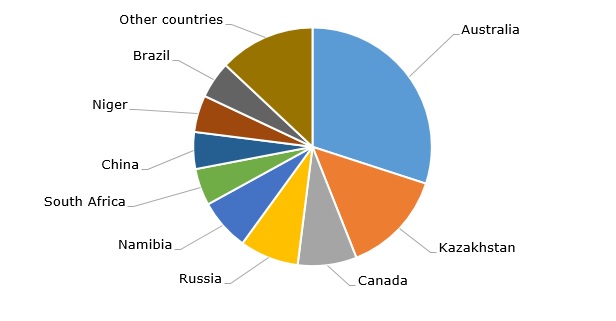5 Leading Uranium Producing Countries In the World
15 Jan 2019 • by Natalie Aster

LONDON – Uranium (a silvery-white, very heavy, weakly radioactive metal) plays a vital role in the modern world as it is an essential element in the generation of nuclear energy, which is required to satisfy the world’s skyrocketing demand for electricity. Besides, uranium is important for the military sector: it is used to power nuclear submarines and in nuclear weapons. Moreover, depleted uranium is applied in the manufacturing of armour and ammunition, and is also used as a counterweight for aircraft and as ballast for ships. However, despite certain benefits of uranium, this metal is considered to be very toxic. It has a negative effect on the functioning of vital organs in the human body (e.g. heart, kidney, liver); exposure to uranium metal or its decay products may cause serious health problems or lead to fatalities.
In nature, uranium occurs in several minerals such as uranite (pitchblende), carnotite, and brannerite. It is also found in monazite sands and phosphate rocks. As of 2017, the world’s total recoverable identified resources of uranium were estimated at more than 6.14 million metric tons. The most abundant deposits of uranium are found in Australia – about 30% of the world’s total. Such countries as Kazakhstan, Canada, Russia, Namibia, South Africa, and China also possesses substantial uranium reserves.
Structure of the global uranium reserves by country, 2017

Globally, uranium production has exhibited a fairly steady increase during the past decade, growing from nearly 41.28 thousand metric tons (TMT) in 2007 to exceed 59.5 TMT in 2017. The record high production volume during that 10-year period was registered in 2016 – slightly over 62.63 TMT. Around 50% of overall uranium output volume is now produced by in situ leaching.
Global uranium mine production volume during 2002-2017 (in TMT) .jpg)
Despite a healthy increase during more than a decade, the uranium production volume still doesn’t fully satisfy the demand for the material. Therefore, historical overproduction is an important contributor to subsequent secondary supplies.
Presently, more than two-thirds of the world’s total supply of uranium comes from Kazakhstan, Canada, and Australia. Read on to have a closer look at the 5 leading uranium mine producing countries in the world:
1. KAZAKHSTAN
Kazakhstan is the top uranium producer by far. It remained at the forefront of the uranium mine production since 2009. Kazakhstan boasts the second largest recoverable uranium resources known worldwide, accounting for appr. 12% of the world’s total. Uranium exploration began in Kazakhstan in 1943, and now there are 17 active mines and nearly 50 deposits across 6 country’s provinces. The country commands a share of around 39% of the world’s total uranium output. In 2017, Kazakhstan produced slightly over 23.39 TMT of uranium – a modest YoY uranium mines decrease from nearly 24.57 TMT in 2016. The country’s uranium production also demonstrated a slight decline in 2018 and is projected to see further cutbacks in the next few years to avoid resource depletion.
Kazakhstan’s uranium mine production volume during 2007-2017 (in TMT).jpg)
2. CANADA
Canada ranks the second leading mine producer of uranium worldwide, holding a share of about 22% in the global uranium output volume. Historically, the country was the top global mine producer of uranium, but it was outpaced by Kazakhstan in 2009. Deposits of uranium were discovered in Canada in the 1930s, however, the exploration began only in the year 1942. Canada is home to the two world’s largest uranium mines – McArthur River and Cigar Lake; both are located in the Northern Saskatchewan. Generally, the country possesses the third biggest reserves of uranium around the globe. Canada’s uranium production decreased from nearly 14 TMT mined in 2016 to appr. 13.11 TMT in 2017.
Canada’s uranium mine production volume during 2007-2017 (in TMT) .jpg)
3. AUSTRALIA
Australia takes the number three spot among the world’s leading uranium producers, accounting for nearly 10% of the global output. The country possesses the most abundant uranium reserves from pole to pole – appr. 30% of the world’s total. The commodity has been mined in Australia since 1954. Currently, uranium, alongside other minerals, represents about 20% of the Australian GDP. Besides, the uranium industry is one of the key sources of employment in the country. Almost all uranium mined in Australia is for export, as the country is reliant on coal for power generation. As of 2017, the Australian mine production of uranium exhibited a modest YoY shrink and totaled some 5.88 TMT, compared to a bit more than 6.3 TMT in 2016.
Australia’s uranium mine production volume during 2007-2017 (in TMT)
.jpg)
4. NAMIBIA
Namibia is the fourth leading uranium producing country, grabbing a share of nearly 7% of the global output volume. The year 2017 was the second consecutive year that the country’s uranium production volume registered healthy growth since 2013, however, it didn’t manage to come the 2013’s level. As of 2016, the Namibian uranium production reached some 3.65 TMT. In 2017, it crossed 4.22 TMT. The country has 2 mines that are capable of supplying around 10% of the global uranium output: Paladin Energy’s Langer Heinrich mine (which was taken offline in May 2017) and Rossing mine majorly owned by Rio Tinto.
Namibia’s uranium mine production volume during 2007-2017 (in TMT).jpg)
5. NIGER
Niger rounds up the top 5 uranium producers with a share of appr. 5.8% in the world’s total uranium supply volume. During 2011-2015, the country held the fourth position on the lest of the leading uranium producers, however, it was outpaced by Namibia in 2016. As of 2017, Niger’s production of uranium fell to 3,449 metric tons, compared to 3,479 metric tons in 2016. There are 2 uranium mines in production in the country. The larger one is an open-pit project operated by SOMAIR’s subsidiary – Areva, which holds a stake in the other country’s mine as well.
Niger’s uranium mine production volume during 2007-2017 (in TMT)
.jpg)
URANIUM PRODUCTION OUTLOOK
Decade-low prices for the material adversely impacted the performance of the existing uranium mines as well as had a devastating effect on the capacity of early-stage uranium projects to raise the required funding to get ready for the demand upturn. However, halted projects, suspended operation on some higher-cost mines, production cuts, and renewed interest from investors have encouraged uranium prices to go up in the H2 2018.
Nevertheless, experts remain uncertain about the long-term outlook for the uranium market. Through 2025, the global demand for uranium may pick up by nearly 40%, majorly owing to a great number of scheduled nuclear reactors projects across the globe. Thus, if demand will continue to ramp up, it could drive the uranium price recovery, and spur the uranium sector to increase in the coming year, as the global uranium resources are enough to meet the mounting demand for the metal.
© MarketPublishers.com, 2019
Analytics & News
